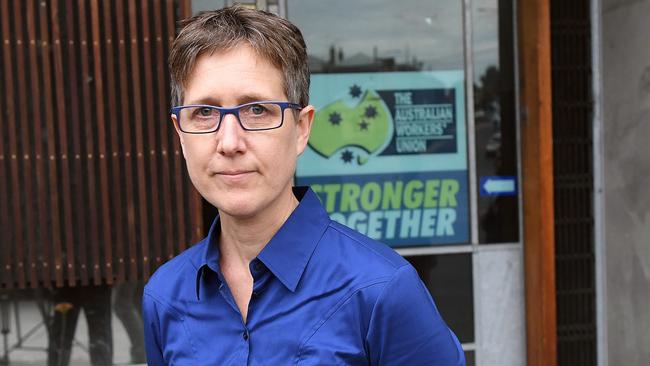
Not since the time Greg Combet was secretary of the Australian Council of Trade Unions has there been a senior ACTU official with more cut-through than a serving of blancmange.
Can anyone even remember Jeff Lawrence, who was secretary between 2007 and 2012, when he was conveniently kicked upstairs to a senior position at the Fair Work Commission?
Then there was Dave Oliver — Dave who? — who was secretary between 2012 and 2017.
And let’s face it, former ACTU president Ged Kearney, now an aspiring Labor state politician, was very ineffective when it came to establishing a strong public profile fighting the good fight on behalf of the workers. Recall that Bob Hawke was once upon a time the president of the ACTU.
These obscure union officials — Lawrence, Oliver and Kearney — oversaw both a decline in the percentage of workers who belong to a trade union as well as an absolute fall in the number of trade union members.
Take the decade ending 2016. At the beginning, nearly 19 per cent of workers belonged to a trade union. By 2016, the proportion had fallen to 14.5 per cent. In the private sector, trade union membership now accounts for less than 10 per cent of the workforce.
In absolute terms, the union movement has lost more than 300,000 workers, with overall membership around 1.5 million. There are slightly more female than male members. And the group with the highest rate of unionisation is professional workers, dominated by teachers and nurses.
For teenagers, only 4 per cent belong to a trade union and for those aged 20 to 24, the rate is just 7 per cent.
These figures do not bode well for the future of unionism.
In the context of this challenge to the union movement’s claim to represent workers — some might call it an existential emergency — along comes Sally McManus, the new ACTU secretary.
A creature of the left and former student politician, she held the relatively obscure position of state secretary of the Australian Services Union before shifting to the ACTU.
It would be fair to say that her approach to the new job has been to come out with all guns blazing. Just last week, McManus declared the right to strike was effectively dead following the decision of the FWC to order train drivers in Sydney to end their overtime ban and to suspend a proposed strike this week.
According to her: “Rail workers followed every single rule and law, and still the minister can get an order to cancel bans on working excessive overtime.” She went on to make the hyperbolic claim that the “right to withdraw labour is a fundamental human right, denied to most Australian workers most of the time”.
The way McManus now sees the situation is that the Fair Work Act just doesn’t cut it; the union movement needs more from the law. To this end, she is spearheading the Change the Rules campaign. If the union movement can’t win the hearts and minds of workers, the hope is that the Labor Party can oblige with rule changes demanded by their union buddies.
Of course, forthright and blunt debate is part and parcel of democratic societies. But in making certain claims about the labour market, McManus leaves herself open to the criticism that she is all too amenable to refusing to let facts get in the way of her arguments.
Take the following among her pet assertions: insecure work is rising and must be curtailed; the labour share of income is at a 50-year low; income inequality is rising and is at a historic high.
Consider the first. According to McManus: “Insecure work, which 40 per cent of Australian workers now find themselves in, means that workers don’t have the power to bargain for pay increases.” It’s not clear where she gets this figure from apart from repeating a mistake made in Brian Howe’s sloppy report commissioned by the ACTU and released in 2012.
But here are the facts. The degree of casualisation of the workforce has not changed from around 20 per cent in more than two decades. Defined as those workers who are not entitled to paid leave, the growth of casual workers was a feature of the 1980s and early 1990s.
Needless to say, most casual jobs are part-time. But if we look at the most recent labour force figures, we note that the vast majority of employment growth has been full-time. For the calendar year 2017, 322,000 out of 393,000 — or 82 per cent — of all new jobs were full-time.
If we look at job tenure, there is very little evidence that jobs are becoming shorter. Forty per cent of employees have been with their current employer for six years or more. In fact, around 10 per cent of employees have been with the same boss for 20 years or more.
Labour hire is another of McManus’s targets. She wants to “take away the incentive for employers to use labour hire” even though the figures suggest that the use of labour hire has actually fallen, not risen.
In 2001, 8 per cent of employees worked for labour hire firms. By 2008, the proportion had fallen to 5 per cent, where it has stayed.
No doubt none of this official information bothers McManus. Among the changes she is currently pushing is the mandatory conversion of casual positions to permanent after six months.
That a clause in a Visy enterprise agreement that all casual workers must be made permanent after three months was struck out by the FWC prompted McManus to claim the system was “completely broken”.
Consider also her claim about rising income inequality, another topic on which facts are seemingly irrelevant.
“A government that cared about growing inequality would be supporting their union movement,” she says. “Instead the Turnbull government uses every opportunity to do the opposite and to side with corporations who already have too much power.”
Again, the evidence points to essentially steady income inequality over the past decade and a half. The best data source — the Household, Income and Labour Dynamics survey — indicates that household incomes adjusted for their number and age and after tax and transfers show steady inequality as measured by the Gini coefficient, the most widely used indicator of inequality.
By all means, let’s have a debate about what’s happening in the labour market and what it means for workers and the unemployed. I’m certainly up for it. But let it be based on facts rather than politically driven, baseless conjectures.



